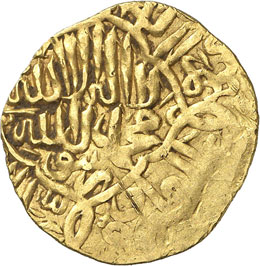- Home
- Vente aux enchères 8
- 294 TIMURID - MUGHAL - THE FIRST APPEARANCE OF THE GOLD COIN ...
Lot 294 - Vente aux enchères 8
Bids
Description
This is the first time that a gold mithqal (ashrafi) of Babur, is being offered for public sale. Zahir al-din Babur, the great-great grandson of Timur Gurkan, began life as a Timurid prince of fortune at a time when the Timurid dynasty had reached the end of its days. He was lucky enough to be encouraged by his distant cousin Husayn Bayqara, who received him frequently in Harat and almost certainly helped to form his more humane character and interests. The fall of the Timurid kingdom of Harat and the rise of the Shaybanids in Samarkand, combined with that of the Safawids in Iran, challenged Babur's ambitions. He destroyed the forces of Ibrahim Lodi, the sultan of Dehli, at the great battle of Panipat in the spring of AH 932 (1526). This was the moment at which the Mughal Empire was born, a Timurid state founded on Indian soil, which was to last until the nineteenth century CE. This coin was issued on the conquest of Hindustan in AH 932 and most likely struck after the battle of Panipat to reward the troops under Babur's command, for he was known to be a generous and liberal general. Since this coin is struck in the Kabul style, but without mint or date, this is most likely the first occasion on which he claimed the title Padshah on his coinage. This piece is a campaign issue struck at a military camp. The silver coinage is plentiful, but the rarity of the gold, this being the first one known, suggests that it was intended by Babur for his generals and viziers. Having ousted Ibrahim Lodi, Babur occupied Delhi and Agra to the south, and then led his forces down the Ganges River as far as Jaunpur. His victory over Rana Sauga of Citor in AH 933 (1527) secured the Rajasthani flank for him, while a second victory over the eastern Afghans in AH 935 (1529) gave him control of India as far as Bengal. Babur died on 6 Jumada I AH 937 (26 December 1530) at Agra, having reigned in India for only five years.
Please use the registration form to send us your participation request, or, if you are already registered and authorized, use the login box on the top.
For any information please contact auction@ngsa.ch
Vente aux enchères 8
Categories
Auction: Vente aux enchères 8
- Celtic Coins
- Greek Coins
- Roman Republic
- Roman Empire
- Byzantine Empire
- The Islamic World
- Albania
- Germany
- Annam
- Holy Roman Empire/Austria
- Belgium
- Cambodia
- Chile
- China
- Denmark
- Spain
- Ethiopia
- France
- French colonial coins
- Great Britain
- Greece
- Crete
- Guatemala
- Holland/Nederlands
- Hungary
- Danish India
- Italy
- Luxembourg
- Mexico
- Monaco
- Montenegro
- Poland
- Portugal
- Russia
- Serbia/Yugoslavia
- Sweden
- Switzerland
- Transylvania
- USA
Timetable
Pre-bidding - End
23 11 2014 16:00 CET
Room auction - Start
24 11 2014 14:00 CET
Live auction - Start
24 11 2014 15:00 CET
Contacts
Rond-point de Plainpalais 1, Ginevra, Genève, Switzerland
 Respecting your privacy is our priority
Respecting your privacy is our priority
This site uses cookies to improve user experience and to collect information on the use of the site. You can read our cookie policy, accept all cookies and continue browsing by clicking on "Accept" or customize your choice by clicking on "Customize".
Cookie Policy
Cookies
To make this site work properly, we sometimes install small data files called "cookies " on your device. Most of the big sites do the same.
What are cookies?
A cookie is a small text file that websites save on your computer or mobile device while you visit them. Thanks to cookies, the site remembers your actions and preferences (for example login, language, font size and other display settings) so that you do not have to re-enter them when you return to the site or browse from one page to another.
How do we use cookies?
Third party cookies
Google Analytics
This site uses Google Analytics to collect information about the use of users of its website. Google Analytics generates statistical and other information through cookies, stored on users' computers. The information generated relating to our website is used to make reports on the use of websites. Googl
How to control and modify cookies?
You can modify or withdraw your consent at any time from the cookie declaration on our website.
Privacy Policy
Find out more about who we are, how you can contact us and how we process personal data in our privacy policy .
The necessary cookies help to make the website usable by enabling basic functions such as page navigation and access to protected areas of the site. The website cannot function properly without these cookies.
| Name | Supplier | Purpose | Expiry |
|---|---|---|---|
| cookieConsent | Bid Inside | Stores the user's cookie consent status for the current domain | 6 months |
| PHPSESSID | Bid Inside | Preserve the user's status in the different pages of the site. | When the browsing session ends |
| f_display | Bid Inside | The f_display cookies memorize the display mode chosen by the user in the pages where there are lists | When the browsing session ends |
| f_page | Bid Inside | The f_page cookies store the page viewed by the user in the pages where there are lists | When the browsing session ends |
| f_rec_page | Bid Inside | The f_rec_page cookies store the number of elements to be displayed per page chosen by the user in the pages in which there are lists | When the browsing session ends |
| f_order_by | Bid Inside | The f_order_by cookies store the sorting parameter selected by the user in the pages where there are lists | When the browsing session ends |
| f_order_dir | Bid Inside | The f_order_dir cookies store the ordering direction chosen by the user in the pages where there are lists | When the browsing session ends |
| watch_list_show_imgs | Bid Inside | The watch_list_show_imgs cookie stores the user's choice to show or hide lot images on the watch list page | When the browsing session ends |
| selected_voice | Bid Inside | The selected_voice cookie stores the voice selected by the user for the speech synthesis present in the live auction | 1 Month |
| include_autobids | Bid Inside | The include_autobids cookie stores the user's choice to show or hide their auto-bids on the 'Your bids' page | 6 months |
Analytical cookies help to understand how visitors interact with the website, collecting and transmitting statistical information to the Data Controller.
| Name | Supplier | Purpose | Expiry |
|---|---|---|---|
| _ga | Register a unique ID used to generate statistical data on how the visitor uses the website. | 2 years | |
| _gat_gtag | Used by Google Analytics to limit the frequency of requests | 1 day | |
| _gat | Used by Google Analytics to limit the frequency of requests | 1 day | |
| _gid | Register a unique ID used to generate statistical data on how the visitor uses the website. | 1 day | |
| __utma | Bid Inside | Used to distinguish users and sessions. The cookie is created when the javascript library executes and no existing __utma cookies exists. The cookie is updated every time data is sent to Google Analytics. | 2 years |
| __utmt | Bid Inside | Used to throttle request rate. | 10 minutes |
| __utmb | Bid Inside | Used to determine new sessions/visits. The cookie is created when the javascript library executes and no existing __utmb cookies exists. The cookie is updated every time data is sent to Google Analytics. | 30 minutes |
| __utmc | Bid Inside | Not used in ga.js. Set for interoperability with urchin.js. Historically, this cookie operated in conjunction with the __utmb cookie to determine whether the user was in a new session/visit. | When the browsing session ends |
| __utmz | Bid Inside | Stores the traffic source or campaign that explains how the user reached your site. The cookie is created when the javascript library executes and is updated every time data is sent to Google Analytics. | 6 months |
| __utmv | Bid Inside | Used to store visitor-level custom variable data. This cookie is created when a developer uses the _setCustomVar method with a visitor level custom variable. This cookie was also used for the deprecated _setVar method. The cookie is updated every time data is sent to Google Analytics. | 2 years |
Preference technical cookies allow a website to remember information that affects the way the site behaves or presents itself, such as your preferred language or the region you are in.
We do not use cookies of this type.Profiling cookies are used for marketing purposes, to monitor website visitors. The intent is to display relevant and engaging ads for the individual user.
We do not use cookies of this type.Unclassified cookies are cookies that are being classified, together with individual cookie providers.
We do not use cookies of this type.





 295
295